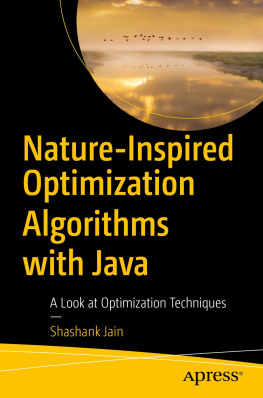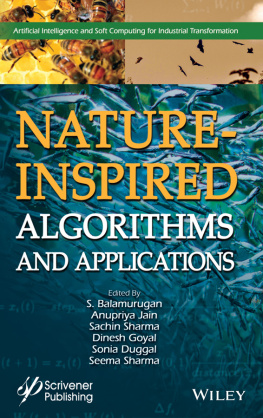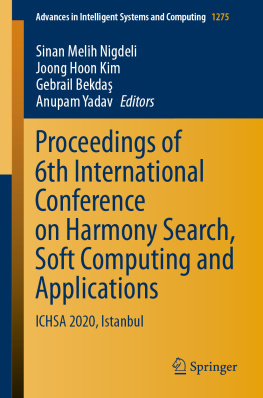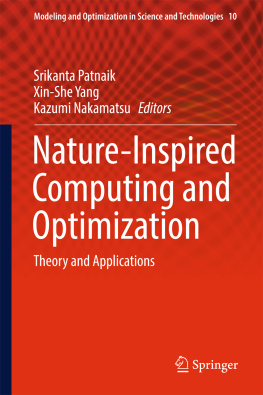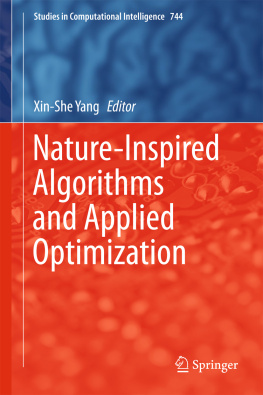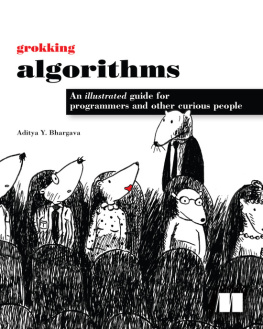Aditya Khamparia - Nature-Inspired Optimization Algorithms
Here you can read online Aditya Khamparia - Nature-Inspired Optimization Algorithms full text of the book (entire story) in english for free. Download pdf and epub, get meaning, cover and reviews about this ebook. year: 2020, publisher: De Gruyter, genre: Romance novel. Description of the work, (preface) as well as reviews are available. Best literature library LitArk.com created for fans of good reading and offers a wide selection of genres:
Romance novel
Science fiction
Adventure
Detective
Science
History
Home and family
Prose
Art
Politics
Computer
Non-fiction
Religion
Business
Children
Humor
Choose a favorite category and find really read worthwhile books. Enjoy immersion in the world of imagination, feel the emotions of the characters or learn something new for yourself, make an fascinating discovery.

- Book:Nature-Inspired Optimization Algorithms
- Author:
- Publisher:De Gruyter
- Genre:
- Year:2020
- Rating:3 / 5
- Favourites:Add to favourites
- Your mark:
- 60
- 1
- 2
- 3
- 4
- 5
Nature-Inspired Optimization Algorithms: summary, description and annotation
We offer to read an annotation, description, summary or preface (depends on what the author of the book "Nature-Inspired Optimization Algorithms" wrote himself). If you haven't found the necessary information about the book — write in the comments, we will try to find it.
Nature-Inspired Optimization Algorithms — read online for free the complete book (whole text) full work
Below is the text of the book, divided by pages. System saving the place of the last page read, allows you to conveniently read the book "Nature-Inspired Optimization Algorithms" online for free, without having to search again every time where you left off. Put a bookmark, and you can go to the page where you finished reading at any time.
Font size:
Interval:
Bookmark:
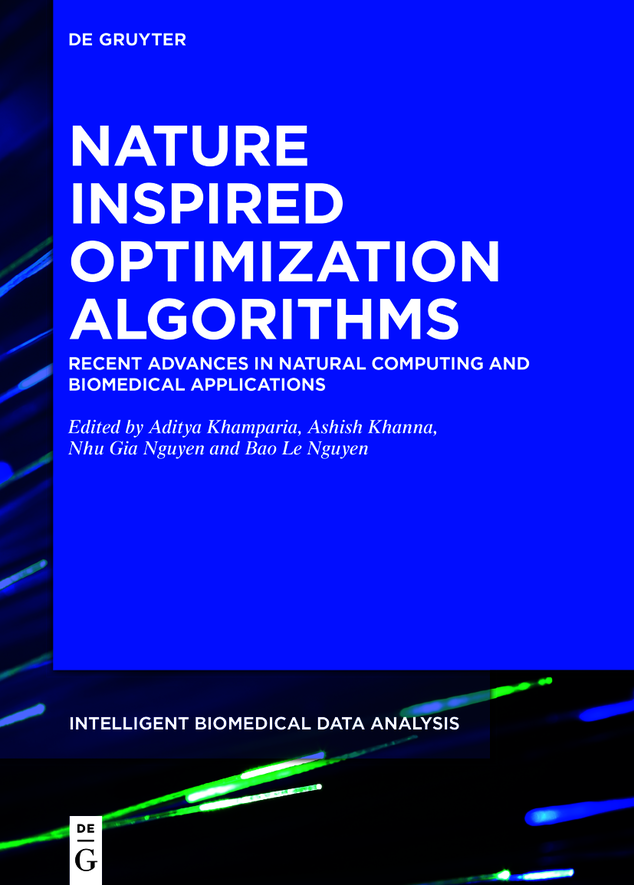
Intelligent Biomedical Data Analysis (IBDA)
Edited by
Volume
ISBN 9783110676068
e-ISBN (PDF) 9783110676112
e-ISBN (EPUB) 9783110676150
Bibliographic information published by the Deutsche Nationalbibliothek
The Deutsche Nationalbibliothek lists this publication in the Deutsche Nationalbibliografie; detailed bibliographic data are available on the Internet at http://dnb.dnb.de.
2021 Walter de Gruyter GmbH, Berlin/Boston
Malware is continuously penetrating the current digital world. Even more alarming are the statistics that reveal that the biomedical industry is presently the most susceptible target of the attackers. The main reasons behind this disquieting situation of attacks on the biomedical industry are its sensitivity level and impact of harm. Moreover, the high cost of medical records is also a major reason for the upsurge in penetration and exploitation. This scenario calls for an effective prevention mechanism to ward off malware attacks on the biomedical or healthcare industry. This research initiative provides an overview of recent statistics of malware attacks in web-based biomedical applications and services. The study also provides a helpful mechanism called malware analysis for preventing malware issues. Further, the study analyzes the malware analysis approach for better and easy understanding and, more importantly, its adoption in biomedical industry. It also provides a ranking assessment/priority assessment of different malware analysis techniques for identifying the most prioritized approach through fuzzy analytic hierarchy process methodology. The study uses a scientifically proven approach for prioritization of analysis techniques and provides a novel idea and path for future researchers.
Malware is the biggest threat for every web-based industry and service. Malware can be more aptly described as the termite that infests digital systems in the current computer era. From sensitive data manipulation to a system failure condition, malware ]. About 61% growth is not small, and the figure reflects the success ratio of malware among the bad actors.
Therefore, an effective and novel security mechanism is necessarily required for preventing malware attacks in every field. The biomedical industry is the recent hot target for bad actors. The impact ratio in biomedical industry is much higher in comparison to other industries. The reason behind this is that new technologies make the production of medicines an accurate and easy process for companies. Every biomedical organization is adopting new web-based production and marketing services to make the process easy and less tedious. Thus, the use of computer and web services in biomedical industry is much higher than in other industries. This gives the attackers ample opportunities to intrude upon highly sensitive data for commercial exploits.
The of this chapter discusses the current malware attack scenario in the biomedical industry. The authors of this chapter cite several articles and relevant literature that attempted to outline effective solutions for malware problems. However, a comparative analysis of the attack statistics and the techniques that have evolved till now seem to be ineffective against the very potent malware. The key reason behind this lacuna is the continuous update process in malware creation and implementation.
Hence, this study aims to address the need for a novel and an appropriate approach for pre-malware identification and security layering in biomedical web-based services. To achieve this outcome, the authors focus is on the malware identification approach called malware analysis. Malware analysis is a process of identifying malware and its behavior through various analysis approaches. A study of a security company declares that the false positive rate of malware analysis is 97% in the general analysis process and, thereafter, if any examiner uses some special kind of analysis (after identifying malware class specifically), they can achieve a 100% success ratio []. The study tries to establish a novel approach for pre-identification of malware in biomedical web-based applications through malware analysis. The authors of this study have used the fuzzy AHP (analytic hierarchy process) methodology for ranking procedure in malware analysis through which the future researchers can identify the best analysis process and its subprocess for work.
The core objective of the researchers in this study is to provide a better and easy path for malware analysis as an identification approach for malware from a web-based biomedical applications perspective. The study provides a ranking of different malware analysis techniques via fuzzy AHP ranking methodology. Hence, this outcome will be the most useful reckoner for future researchers, because with the help of these rankings, researchers can mold and systematize their work and provide a standard, common, and novel unified malware analysis model.
The first segment of this chapter provides an overview of the present situation in malware attacks and its implications in biomedical industry. The second part of the chapter discusses the malware analysis approaches and its different types for easy understanding of and knowledge on the topic. The third section of the chapter gives an overview of the fuzzy AHP methodology that is used for prioritization assessment. The ensuing section tabulates the calculations enlisted to rank different malware analysis approaches for providing informative knowledge to future researchers. Finally, the authors have discussed the significance and limitations of the chapter. The study concludes by citing future possibilities for research in this domain.
Currently, malware attacks are at their peak level. The reason for the burgeoning malware attacks is an easy access to the Internet. To draw an analogy, in a beehive, if a honeycomb has a large number of bees in comparison to others, the bear first attacks the larger one and then the small ones. Similarly, since the users are feeding the malware platform with a large amount of data, the attackers target it first for their unethical intentions. The biomedical industry is associated with the most phenomenal and elemental human assets, that is, health. Ever since the industry took on a digital transformation, all data including the highly classified information about the health record of the patients are now stored digitally. Hence, in the current context of data extraction, the industry has become the most prioritized target for data breaches. The cost of medical data on the dark web is also a major lure for the data predators. A report describes that the cost of medical information on a deep/dark web platform, based on the amount and sensitivity of the information, ranges from $1 to $1,000 per record []. Before talking about the critical attack scenario and statistics related to the biomedical industries, it is important to understand the overall malware attack scenario for a better understanding.
Font size:
Interval:
Bookmark:
Similar books «Nature-Inspired Optimization Algorithms»
Look at similar books to Nature-Inspired Optimization Algorithms. We have selected literature similar in name and meaning in the hope of providing readers with more options to find new, interesting, not yet read works.
Discussion, reviews of the book Nature-Inspired Optimization Algorithms and just readers' own opinions. Leave your comments, write what you think about the work, its meaning or the main characters. Specify what exactly you liked and what you didn't like, and why you think so.

